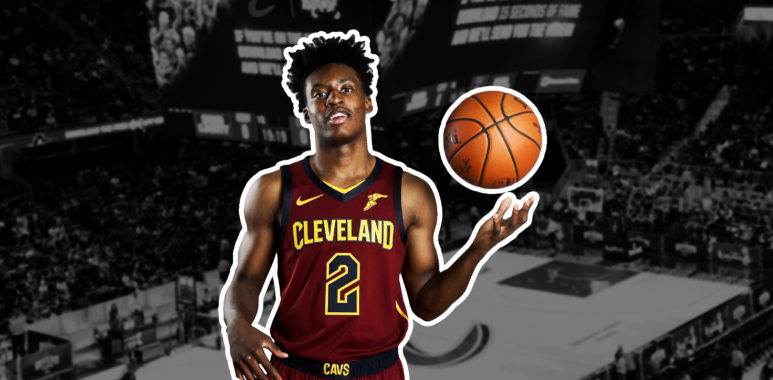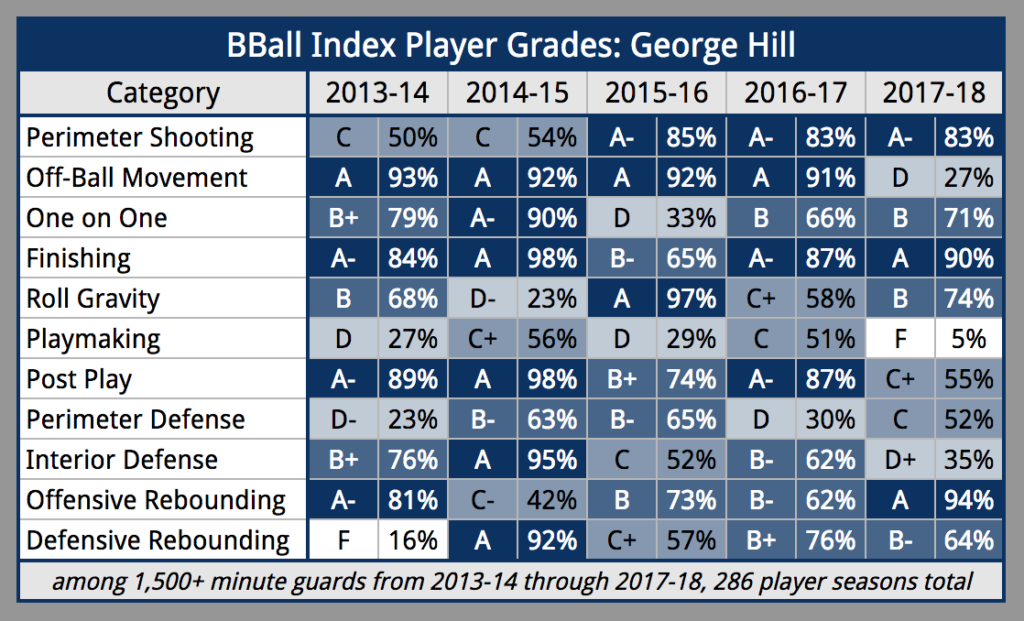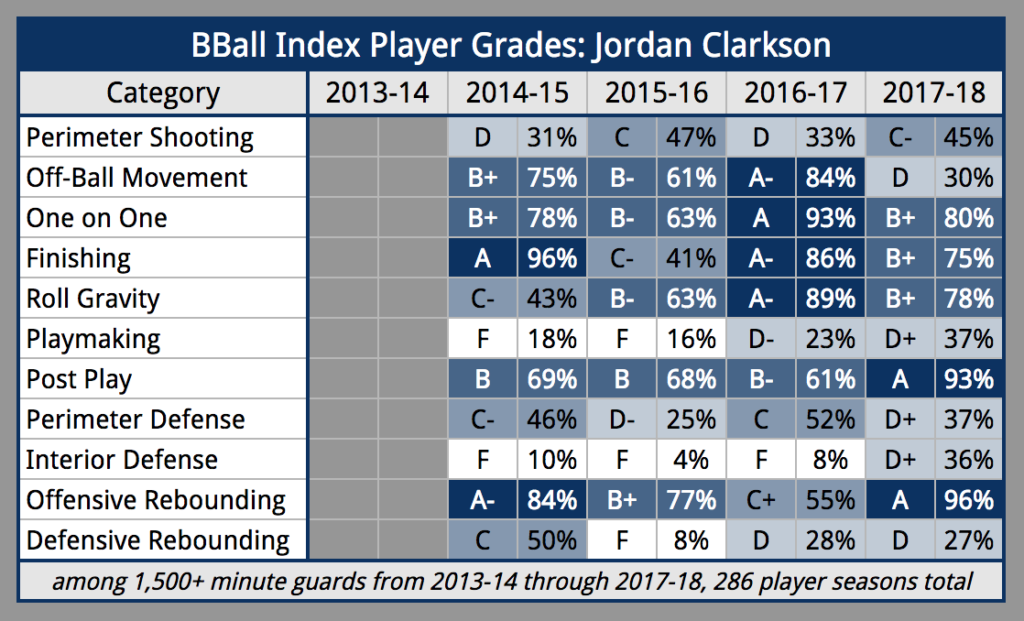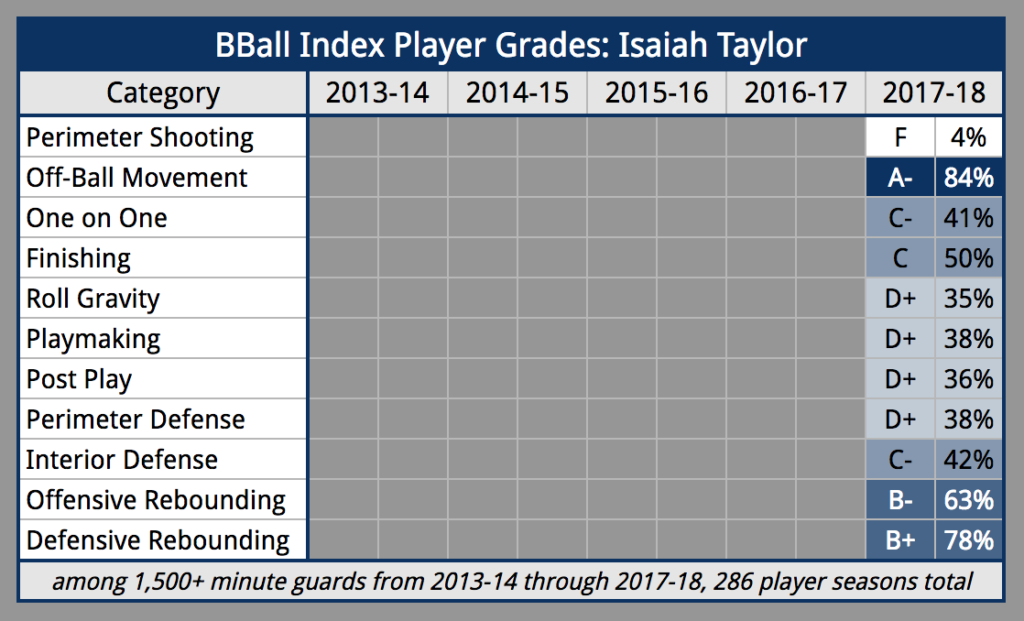
The Guards of the Cavaliers
The Cleveland Cavaliers will rely on a mix of veterans and young players for shot creation during the 2018-19 season.
George Hill
6’3” tall, 188 lbs, 32.4 years old
Entering his 11th NBA season, Hill is a savvy veteran that’s more game-manager than dynamic weapon at this point in his career. His age is a concern, as most players are on the downslope of the aging curve during their age 32 season. Both his offensive and defensive Player Impact Plus-Minus (PIPM) were below career averages last year, possibly indicating that decline is already well on its way. His BBI grades have remained relatively stable the last few years, but with noticeable decline in a couple areas. BBI career arc projections expect that trend to continue, with some decline but overall his talent remaining relatively stable.
On the other hand, joining new teams comes with a learning curve. Hill faced this obstacle twice last season after signing with the Sacramento Kings in the summer and then being traded to the Cavaliers at the trade deadline. Though the Cavalier roster had some major changes over the summer, Hill’s relative continuity going into 2018-19 may benefit his performance to some degree.
Another concern with Hill is durability. He’s missed an average of 24 games per year over the past four seasons. The amount of time he misses this year will have a significant impact on the quality of the Cavaliers guard play.
One additional factor to consider is that Hill, for all intents and purposes, is an expiring contract. His $18 million salary in 2019-20 is only guaranteed for $1 million, which could make him an appealing trade target at the deadline—if his performance proves he’s still good enough to contribute to a playoff team.

Hill’s perimeter shooting has been consistently excellent over the last three years, a trend that’s likely to continue this season. His off-ball movement received straight A’s four years in a row—right up until he experienced Sacramento and Cleveland last year. Whether that aspect of his game will rebound in a Cleveland offense no longer centered on LeBron James remains to be seen. His one on one game and post play are both solid despite being featured infrequently. An excellent finisher, he’s shot better than 67% at the rim five of the last six years.
Perhaps the weakest part of Hill’s offensive game is his playmaking. It was completely absent last season on both teams he played for. This was never a strength for him, ranging from poor to average in prior years, but never before had he been flat out terrible in this regard. This is of particular concern to Cleveland because they now have very few playmakers on the roster. Even a small bounce-back from him in this regard would have a large impact on the team offense.
Defensively, Hill remains solid on the perimeter. His lateral agility at the point of attack can be an issue, but he has good footwork and anticipation which enable him to get by even when facing a speed deficit. He displays good court awareness and has the length to switch up a position if needed. He rebounds his position well on both ends of the court. He’s capable of being a cog in a solid team defense, but don’t expect too many high impact plays.
Collin Sexton
6’3” tall, 190 lbs, 19.8 years old
Selected with the Brooklyn pick the Cavaliers acquired in the Kyrie Irving trade, Sexton is the last hope for Cleveland to recoup any value from that deal. An intense competitor with impressive speed with the ball in his hand, he has the potential to become a dynamic lead guard. However, there are two concerns that could hold him back from reaching his potential.
The first concern is a reckless style of play. Sexton displays intelligence off the court, but his on-court basketball IQ is lacking. His shot selection and decision making are inclined towards an inefficient style of basketball. He often chooses to launch ill-advised contested mid-range shots instead of finding his open teammates. Within the team context at Alabama, a defense-oriented team with very few offensive weapons, this was understandable. But to realize his potential in the NBA, he’ll need to improve this aspect of his game.
The second concern is questionable 3-point shooting. Sexton’s perimeter shooting wasn’t exactly a liability once factoring in shooting difficulty, but certainly wasn’t an asset either (44-131, 33.6%). His free throw numbers indicate that the underlying form may be sound (196-252, 77.8%), but this is merely an indicator rather than proof. To help us dig deeper into his shooting ability, I enlisted the help of our shot form asset, Dylan Ward:
“The stroke motion in his shot pocket is quick in a bit of a violent way. He has a two-part stroke. He gets good rhythm off the dribble (best from mid-range) because he transfers the ball into his shot pocket and goes into his shot smoothly. He prefers this rhythm:
powered by Advanced iFrame free. Get the Pro version on CodeCanyon.
You can see he uses good wrist action, but you can also see the stiffness in the off-arm when it comes off the ball. He is pretty stiff, and this contributes to his shooting motion in the pocket being violent/quick. He often has a hunched posture after releasing the ball. Arc/trajectory is an issue, and will be going forward. He uses his legs well, consistently. Deep range is an issue because of the stiffness and arc/trajectory issue. Seems dedicated to try to incorporate good mechanics, with the consistent leg use and wrist use. Shooting success doesn’t come naturally to him, though.”
As with his shooting results, there is both good and bad in this shot form assessment. Will he be able to make adjustments to his shooting arc to find consistency from long range? Will his hard work overcome the lack of naturalness in his shooting form? While fixing these issues are long-term projects for Sexton, his progress (or lack thereof) will impact the success of the position group this season.
Jordan Clarkson
6’5” tall, 194 lbs, 26.4 years old
Now seen by many as merely the cost of acquiring Larry Nance Jr., Clarkson is a dynamic but inefficient scorer. With two years remaining on his fringe starter level deal, you can expect him to be on the roster the entire year. Entering his 5th NBA season there’s still some hope for improvement, but he’s reached a stage in his career that, combined with his age, means he’s likely close to a finished product. BBI growth curves indicate some incremental improvements can be expected over the next couple years, but also that he may have already peaked in areas like one on one, playmaking and defense.

Clarkson is an effective one on one player with good finishing skills, but he fails to utilize these skills as vehicle to good team offense. His playmaking has ranged from terrible to poor during his career, and in the postseason last spring the tunnel vision reached a high water mark with just 1.6 assists per 36 minutes. This predictability ruined his efficiency, with an atrocious 35.8% true shooting mark against defenses baiting him into his most inefficient tendencies. Combined with his lackluster defense, it’s uncertain where he fits into an NBA rotation.
Isaiah Taylor
6’3” tall, 170 lbs, 24.3 years old
The last man on the roster, Taylor’s minimum contract has a guarantee date of January 10, 2019. Whether he will stick on the roster through the season or not depends on the impression he makes on the coaching staff, but he showed some promise in Atlanta last year. The lack of a 3-point shot caps his ceiling, but he proved to be a solid ball-handler and capable distributor. That’s a useful skill set to have as emergency depth.

Conclusion
All-in-all, the Cavs’ guard rotation is underwhelming. As a position group they rank No. 22 in the NBA at playmaking and No. 21 at perimeter defense. Will Hill remain healthy and avoid further age-related decline? Will Sexton display improved decision making and shooting mechanics? These are the key questions in determining how this group will fare. Will they approach adequate guard play, or are they doomed to being one of the worst guard rotations in the league? Only time will tell.
Special thanks to Riley Gisseman (header image), Dylan Ward (shot form assessment), Jeff Siegel (contract information) and Derek Grubis (data support) for their contributions to this article.
